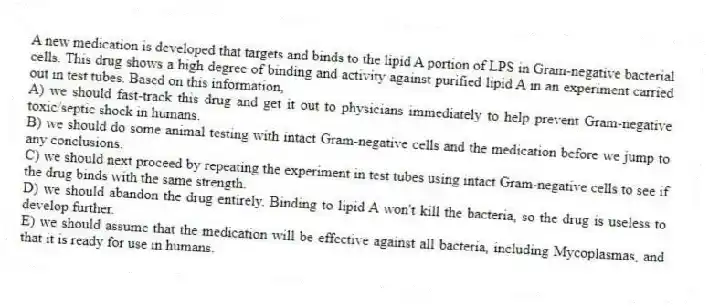
A new medication is developed that targets and binds to the lipid A portion of LPS in Gram-negative bacterial cells. This drug shows a high degree of binding and activity against purified lipid A in an experiment carried out in test tubes. Based on this information,
A) we should fast-track this drug and get it out to physicians immediately to help prevent Gram-negative toxic/septic shock in humans.
B) we should do some animal testing with intact Gram-negative cells and the medication before we jump to any conclusions.
C) we should next proceed by repeating the experiment in test tubes using intact Gram-negative cells to see if the drug binds with the same strength.
D) we should abandon the drug entirely. Binding to lipid A won't kill the bacteria, so the drug is useless to develop further.
E) we should assume that the medication will be effective against all bacteria, including Mycoplasmas, and that it is ready for use in humans.
Correct Answer:
Verified
Q58: The structures used for motility in both
Q59: Which is NOT True of mitochondria and
Q60: Extrachromasomal DNA is found in _.
A) mitochondria
Q61: You explain to Petrus and his grandmother
Q62: A patient comes to see you, complaining
Q64: Prokaryotes may ingest particles via phagocytosis.
Q65: A research laboratory is investigating environmental factors
Q66: Mitochondria and chloroplasts are thought to have
Q67: You want to examine the structure of
Q68: The lab report also details the results
Unlock this Answer For Free Now!
View this answer and more for free by performing one of the following actions

Scan the QR code to install the App and get 2 free unlocks

Unlock quizzes for free by uploading documents